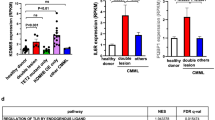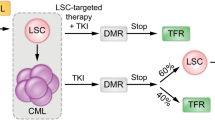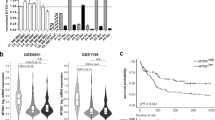Abstract
Chronic myeloid leukemia (CML) is driven by malignant stem cells that can persist despite therapy. We have identified Metastasis suppressor 1 (Mtss1/MIM) to be downregulated in hematopoietic stem and progenitor cells from leukemic transgenic SCLtTA/Bcr-Abl mice and in patients with CML at diagnosis, and Mtss1 was restored when patients achieved complete remission. Forced expression of Mtss1 decreased clonogenic capacity and motility of murine myeloid progenitor cells and reduced tumor growth. Viral transduction of Mtss1 into lineage-depleted SCLtTA/Bcr-Abl bone marrow cells decreased leukemic cell burden in recipients, and leukemogenesis was reduced upon injection of Mtss1-overexpressing murine myeloid 32D cells. Tyrosine kinase inhibitor (TKI) therapy and reversion of Bcr-Abl expression increased Mtss1 expression but failed to restore it to control levels. CML patient samples revealed higher DNA methylation of specific Mtss1 promoter CpG sites that contain binding sites for Kaiso and Rest transcription factors. In summary, we identified a novel tumor suppressor in CML stem cells that is downregulated by both Bcr-Abl kinase-dependent and -independent mechanisms. Restored Mtss1 expression markedly inhibits primitive leukemic cell biology in vivo, providing a therapeutic rationale for the Bcr-Abl-Mtss1 axis to target TKI-resistant CML stem cells in patients.
This is a preview of subscription content, access via your institution
Access options
Subscribe to this journal
Receive 12 print issues and online access
$259.00 per year
only $21.58 per issue
Buy this article
- Purchase on Springer Link
- Instant access to full article PDF
Prices may be subject to local taxes which are calculated during checkout





Similar content being viewed by others
References
Jongen-Lavrencic M, Salesse S, Delwel R, Verfaillie CM . BCR/ABL-mediated downregulation of genes implicated in cell adhesion and motility leads to impaired migration toward CCR7 ligands CCL19 and CCL21 in primary BCR/ABL-positive cells. Leukemia 2005; 19: 373–380.
Zhang B, Li M, McDonald T, Holyoake TL, Moon RT, Campana D et al. Microenvironmental protection of CML stem and progenitor cells from tyrosine kinase inhibitors through N-cadherin and Wnt-beta-catenin signaling. Blood 2013; 121: 1824–1838.
Bolton-Gillespie E, Schemionek M, Klein HU, Flis S, Hoser G, Lange T et al. Genomic instability may originate from imatinib-refractory chronic myeloid leukemia stem cells. Blood 2013; 121: 4175–4183.
Rothe K, Lin H, Lin KB, Leung A, Wang HM, Malekesmaeili M et al. The core autophagy protein ATG4B is a potential biomarker and therapeutic target in CML stem/progenitor cells. Blood 2014; 123: 3622–3634.
Daley GQ, Van Etten RA, Baltimore D . Induction of chronic myelogenous leukemia in mice by the P210bcr/abl gene of the Philadelphia chromosome. Science 1990; 247: 824–830.
Druker BJ, Guilhot F, O'Brien SG, Gathmann I, Kantarjian H, Gattermann N et al. Five-year follow-up of patients receiving imatinib for chronic myeloid leukemia. N Engl J Med 2006; 355: 2408–2417.
Hamilton A, Helgason GV, Schemionek M, Zhang B, Myssina S, Allan EK et al. Chronic myeloid leukemia stem cells are not dependent on Bcr-Abl kinase activity for their survival. Blood 2012; 119: 1501–1510.
Corbin AS, Agarwal A, Loriaux M, Cortes J, Deininger MW, Druker BJ . Human chronic myeloid leukemia stem cells are insensitive to imatinib despite inhibition of BCR-ABL activity. J Clin Invest 2011; 121: 396–409.
Kumari A, Brendel C, Hochhaus A, Neubauer A, Burchert A . Low BCR-ABL expression levels in hematopoietic precursor cells enable persistence of chronic myeloid leukemia under imatinib. Blood 2012; 119: 530–539.
Makishima H, Jankowska AM, McDevitt MA, O'Keefe C, Dujardin S, Cazzolli H et al. CBL, CBLB, TET2, ASXL1, and IDH1/2 mutations and additional chromosomal aberrations constitute molecular events in chronic myelogenous leukemia. Blood 2011; 117: e198–e206.
Hu X, Yang D, Zimmerman M, Liu F, Yang J, Kannan S et al. IRF8 regulates acid ceramidase expression to mediate apoptosis and suppresses myelogeneous leukemia. Cancer Res 2011; 71: 2882–2891.
Li Y, Yang L, Pan Y, Yang J, Shang Y, Luo J . Methylation and decreased expression of SHP-1 are related to disease progression in chronic myelogenous leukemia. Oncol Rep 2014; 31: 2438–2446.
Strathdee G, Holyoake TL, Sim A, Parker A, Oscier DG, Melo JV et al. Inactivation of HOXA genes by hypermethylation in myeloid and lymphoid malignancy is frequent and associated with poor prognosis. Clin Cancer Res 2007; 13: 5048–5055.
Fan H, Chen L, Zhang F, Quan Y, Su X, Qiu X et al. MTSS1, a novel target of DNA methyltransferase 3B, functions as a tumor suppressor in hepatocellular carcinoma. Oncogene 2012; 31: 2298–2308.
Isaksson HS, Sorbe B, Nilsson TK . Whole genome expression profiling of blood cells in ovarian cancer patients -prognostic impact of the CYP1B1, MTSS1, NCALD, and NOP14. Oncotarget 2014; 5: 4040–4049.
Hicks DG, Yoder BJ, Short S, Tarr S, Prescott N, Crowe JP et al. Loss of breast cancer metastasis suppressor 1 protein expression predicts reduced disease-free survival in subsets of breast cancer patients. Clin Cancer Res 2006; 12: 6702–6708.
Xie F, Ye L, Chen J, Wu N, Zhang Z, Yang Y et al. The impact of Metastasis Suppressor-1, MTSS1, on oesophageal squamous cell carcinoma and its clinical significance. J Transl Med 2011; 9: 95.
Kayser G, Csanadi A, Kakanou S, Prasse A, Kassem A, Stickeler E et al. Downregulation of MTSS1 expression is an independent prognosticator in squamous cell carcinoma of the lung. Br J Cancer 2015; 112: 866–873.
Schemionek M, Kharabi Masouleh B, Klaile Y, Krug U, Hebestreit K, Schubert C et al. Identification of the adapter molecule MTSS1 as a potential oncogene-specific tumor suppressor in acute myeloid leukemia. PloS One 2015; 10: e0125783.
Lee SH, Kerff F, Chereau D, Ferron F, Klug A, Dominguez R . Structural basis for the actin-binding function of missing-in-metastasis. Structure 2007; 15: 145–155.
Cao M, Zhan T, Ji M, Zhan X . Dimerization is necessary for MIM-mediated membrane deformation and endocytosis. Biochem J 2012; 446: 469–475.
Zhong J, Shaik S, Wan L, Tron AE, Wang Z, Sun L et al. SCF beta-TRCP targets MTSS1 for ubiquitination-mediated destruction to regulate cancer cell proliferation and migration. Oncotarget 2013; 4: 2339–2353.
Wu W, Wang Z, Yang P, Yang J, Liang J, Chen Y et al. MicroRNA-135b regulates metastasis suppressor 1 expression and promotes migration and invasion in colorectal cancer. Mol Cell Biochem 2014; 388: 249–259.
Kedmi M, Ben-Chetrit N, Korner C, Mancini M, Ben-Moshe NB, Lauriola M et al. EGF induces microRNAs that target suppressors of cell migration: miR-15b targets MTSS1 in breast cancer. Sci Signal 2015; 8: ra29.
Elling C, Erben P, Walz C, Frickenhaus M, Schemionek M, Stehling M et al. Novel imatinib-sensitive PDGFRA-activating point mutations in hypereosinophilic syndrome induce growth factor independence and leukemia-like disease. Blood 2011; 117: 2935–2943.
Hamilton A, Elrick L, Myssina S, Copland M, Jorgensen H, Melo JV et al. BCR-ABL activity and its response to drugs can be determined in CD34+ CML stem cells by CrkL phosphorylation status using flow cytometry. Leukemia 2006; 20: 1035–1039.
Schemionek M, Elling C, Steidl U, Baumer N, Hamilton A, Spieker T et al. BCR-ABL enhances differentiation of long-term repopulating hematopoietic stem cells. Blood 2010; 115: 3185–3195.
Dieterich P, Klages R, Preuss R, Schwab A . Anomalous dynamics of cell migration. Proc Natl Acad Sci USA 2008; 105: 459–463.
Utikal J, Gratchev A, Muller-Molinet I, Oerther S, Kzhyshkowska J, Arens N et al. The expression of metastasis suppressor MIM/MTSS1 is regulated by DNA methylation. Int J Cancer 2006; 119: 2287–2293.
Mathelier A, Zhao X, Zhang AW, Parcy F, Worsley-Hunt R, Arenillas DJ et al. JASPAR 2014: an extensively expanded and updated open-access database of transcription factor binding profiles. Nucleic Acids Res 2014; 42 (Database issue): D142–D147.
Korhonen J, Martinmaki P, Pizzi C, Rastas P, Ukkonen E . MOODS: fast search for position weight matrix matches in DNA sequences. Bioinformatics 2009; 25: 3181–3182.
Wilczynski B, Dojer N, Patelak M, Tiuryn J . Finding evolutionarily conserved cis-regulatory modules with a universal set of motifs. BMC Bioinformatics 2009; 10: 82.
Haferlach T, Kohlmann A, Wieczorek L, Basso G, Kronnie GT, Bene MC et al. Clinical utility of microarray-based gene expression profiling in the diagnosis and subclassification of leukemia: report from the International Microarray Innovations in Leukemia Study Group. J Clin Oncol 2010; 28: 2529–2537.
Kohlmann A, Kipps TJ, Rassenti LZ, Downing JR, Shurtleff SA, Mills KI et al. An international standardization programme towards the application of gene expression profiling in routine leukaemia diagnostics: the Microarray Innovations in LEukemia study prephase. Br J Haematol 2008; 142: 802–807.
Benita Y, Cao Z, Giallourakis C, Li C, Gardet A, Xavier RJ . Gene enrichment profiles reveal T-cell development, differentiation, and lineage-specific transcription factors including ZBTB25 as a novel NF-AT repressor. Blood 2010; 115: 5376–5384.
Hogge DE, Lansdorp PM, Reid D, Gerhard B, Eaves CJ . Enhanced detection, maintenance, and differentiation of primitive human hematopoietic cells in cultures containing murine fibroblasts engineered to produce human steel factor, interleukin-3, and granulocyte colony-stimulating factor. Blood 1996; 88: 3765–3773.
Schemionek M, Spieker T, Kerstiens L, Elling C, Essers M, Trumpp A et al. Leukemic spleen cells are more potent than bone marrow-derived cells in a transgenic mouse model of CML. Leukemia 2012; 26: 1030–1037.
Yamashita S, Tsujino Y, Moriguchi K, Tatematsu M, Ushijima T . Chemical genomic screening for methylation-silenced genes in gastric cancer cell lines using 5-aza-2'-deoxycytidine treatment and oligonucleotide microarray. Cancer Sci 2006; 97: 64–71.
Smiraglia DJ, Rush LJ, Fruhwald MC, Dai Z, Held WA, Costello JF et al. Excessive CpG island hypermethylation in cancer cell lines versus primary human malignancies. Hum Mol Genet 2001; 10: 1413–1419.
Neviani P, Harb JG, Oaks JJ, Santhanam R, Walker CJ, Ellis JJ et al. PP2A-activating drugs selectively eradicate TKI-resistant chronic myeloid leukemic stem cells. J Clin Invest 2013; 123: 4144–4157.
Zhang H, Peng C, Hu Y, Li H, Sheng Z, Chen Y et al. The Blk pathway functions as a tumor suppressor in chronic myeloid leukemia stem cells. Nat Genet 2012; 44: 861–871.
Chen Y, Sullivan C, Peng C, Shan Y, Hu Y, Li D et al. A tumor suppressor function of the Msr1 gene in leukemia stem cells of chronic myeloid leukemia. Blood 2011; 118: 390–400.
Yu D, Zhan XH, Zhao XF, Williams MS, Carey GB, Smith E et al. Mice deficient in MIM expression are predisposed to lymphomagenesis. Oncogene 2012; 31: 3561–3568.
Wang J, Li J, Shen J, Wang C, Yang L, Zhang X . MicroRNA-182 downregulates metastasis suppressor 1 and contributes to metastasis of hepatocellular carcinoma. BMC Cancer 2012; 12: 227.
Mertz KD, Pathria G, Wagner C, Saarikangas J, Sboner A, Romanov J et al. MTSS1 is a metastasis driver in a subset of human melanomas. Nat Commun 2014; 5: 3465.
Lei R, Tang J, Zhuang X, Deng R, Li G, Yu J et al. Suppression of MIM by microRNA-182 activates RhoA and promotes breast cancer metastasis. Oncogene 2014; 33: 1287–1296.
Krause DS, Lazarides K, Lewis JB, von Andrian UH, Van Etten RA . Selectins and their ligands are required for homing and engraftment of BCR-ABL1+ leukemic stem cells in the bone marrow niche. Blood 2014; 123: 1361–1371.
Jiang Y, Zhao RC, Verfaillie CM . Abnormal integrin-mediated regulation of chronic myelogenous leukemia CD34+ cell proliferation: BCR/ABL up-regulates the cyclin-dependent kinase inhibitor, p27Kip, which is relocated to the cell cytoplasm and incapable of regulating cdk2 activity. Proc Natl Acad Sci USA 2000; 97: 10538–10543.
Mali RS, Ramdas B, Ma P, Shi J, Munugalavadla V, Sims E et al. Rho kinase regulates the survival and transformation of cells bearing oncogenic forms of KIT, FLT3, and BCR-ABL. Cancer Cell 2011; 20: 357–369.
Cancelas JA, Lee AW, Prabhakar R, Stringer KF, Zheng Y, Williams DA . Rac GTPases differentially integrate signals regulating hematopoietic stem cell localization. Nat Med 2005; 11: 886–891.
Thomas EK, Cancelas JA, Zheng Y, Williams DA . Rac GTPases as key regulators of p210-BCR-ABL-dependent leukemogenesis. Leukemia 2008; 22: 898–904.
Chaudhary F, Lucito R, Tonks NK . Missing-in-Metastasis regulates cell motility and invasion via PTPdelta-mediated changes in SRC activity. Biochem J 2015; 465: 89–101.
Tabe Y, Jin L, Iwabuchi K, Wang RY, Ichikawa N, Miida T et al. Role of stromal microenvironment in nonpharmacological resistance of CML to imatinib through Lyn/CXCR4 interactions in lipid rafts. Leukemia 2012; 26: 883–892.
Callahan CA, Ofstad T, Horng L, Wang JK, Zhen HH, Coulombe PA et al. MIM/BEG4, a Sonic hedgehog-responsive gene that potentiates Gli-dependent transcription. Genes Dev 2004; 18: 2724–2729.
Li M, Makkinje A, Damuni Z . The myeloid leukemia-associated protein SET is a potent inhibitor of protein phosphatase 2A. J Biol Chem 1996; 271: 11059–11062.
Roman-Gomez J, Castillejo JA, Jimenez A, Cervantes F, Boque C, Hermosin L et al. Cadherin-13, a mediator of calcium-dependent cell-cell adhesion, is silenced by methylation in chronic myeloid leukemia and correlates with pretreatment risk profile and cytogenetic response to interferon alfa. J Clin Oncol 2003; 21: 1472–1479.
Kantarjian HM, O'Brien S, Cortes J, Giles FJ, Faderl S, Issa JP et al. Results of decitabine (5-aza-2'deoxycytidine) therapy in 130 patients with chronic myelogenous leukemia. Cancer 2003; 98: 522–528.
Hollenbach PW, Nguyen AN, Brady H, Williams M, Ning Y, Richard N et al. A comparison of azacitidine and decitabine activities in acute myeloid leukemia cell lines. PloS One 2010; 5: e9001.
Oki Y, Kantarjian HM, Gharibyan V, Jones D, O'Brien S, Verstovsek S et al. Phase II study of low-dose decitabine in combination with imatinib mesylate in patients with accelerated or myeloid blastic phase of chronic myelogenous leukemia. Cancer 2007; 109: 899–906.
Kuck D, Caulfield T, Lyko F, Medina-Franco JL . Nanaomycin A selectively inhibits DNMT3B and reactivates silenced tumor suppressor genes in human cancer cells. Mol Cancer Ther 2010; 9: 3015–3023.
Hurtz C, Hatzi K, Cerchietti L, Braig M, Park E, Kim YM et al. BCL6-mediated repression of p53 is critical for leukemia stem cell survival in chronic myeloid leukemia. J Exp Med 2011; 208: 2163–2174.
Yoon HG, Chan DW, Reynolds AB, Qin J, Wong J . N-CoR mediates DNA methylation-dependent repression through a methyl CpG binding protein Kaiso. Mol Cell 2003; 12: 723–734.
Cofre J, Menezes JR, Pizzatti L, Abdelhay E . Knock-down of Kaiso induces proliferation and blocks granulocytic differentiation in blast crisis of chronic myeloid leukemia. Cancer Cell Int 2012; 12: 28.
Acknowledgements
The authors thank Kristina Feldberg for excellent technical assistance. MS has received grant funding by the Medical Faculty, RWTH Aachen University (Start-691306-46/13). SK has received grant funding by the German Research Foundation (DFG KO 2155/2-2) and by the German José Carreras Leukemia Foundation (DJCLS grant 10/23). TH has received grant funding by the Cancer Research UK (CRUK) programme (C11074/A11008).
Author contributions
MS, AS, IGC, CMT, SL, TLH, THB and SK designed research. MS, OH, MMR, NC, NK, CS, SH, EGG, SKi, TB, AH, VH and MC performed research. MS, OH, IGC, AS and SK analyzed data. MS, TLH, THB and SK wrote the manuscript.
Author information
Authors and Affiliations
Corresponding author
Ethics declarations
Competing interests
SK has received research funding from Novartis and the Novartis Foundation, provided consultancy for and participated in advisory boards for Ariad, Bristol-Myers Squibb, Novartis and Pfizer, and has received honoraria and travel grants from Ariad, Bristol-Myers Squibb, Novartis and Pfizer. MC has received research funding from Novartis and Bristol-Myers Squibb, is an advisory board member for Bristol-Myers Squibb, Novartis, Ariad and Pfizer, has received travel reimbursement from Bristol-Myers Squibb and Novartis and has received honoraria from Bristol-Myers Squibb, Novartis, Ariad and Pfizer. All other authors declare no conflict of interest.
Additional information
Supplementary Information accompanies this paper on the Leukemia website
Supplementary information
Rights and permissions
About this article
Cite this article
Schemionek, M., Herrmann, O., Reher, M. et al. Mtss1 is a critical epigenetically regulated tumor suppressor in CML. Leukemia 30, 823–832 (2016). https://doi.org/10.1038/leu.2015.329
Received:
Revised:
Accepted:
Published:
Issue Date:
DOI: https://doi.org/10.1038/leu.2015.329
This article is cited by
-
Downregulation of MTSS1 in acute myeloid leukemia is associated with a poor prognosis, chemotherapy resistance, and disease aggressiveness
Leukemia (2021)
-
Early and late stage MPN patients show distinct gene expression profiles in CD34+ cells
Annals of Hematology (2021)
-
Therapeutic inhibition of FcγRIIb signaling targets leukemic stem cells in chronic myeloid leukemia
Leukemia (2020)
-
Infliximab therapy together with tyrosine kinase inhibition targets leukemic stem cells in chronic myeloid leukemia
BMC Cancer (2019)
-
Stem cell persistence in CML is mediated by extrinsically activated JAK1-STAT3 signaling
Leukemia (2019)



